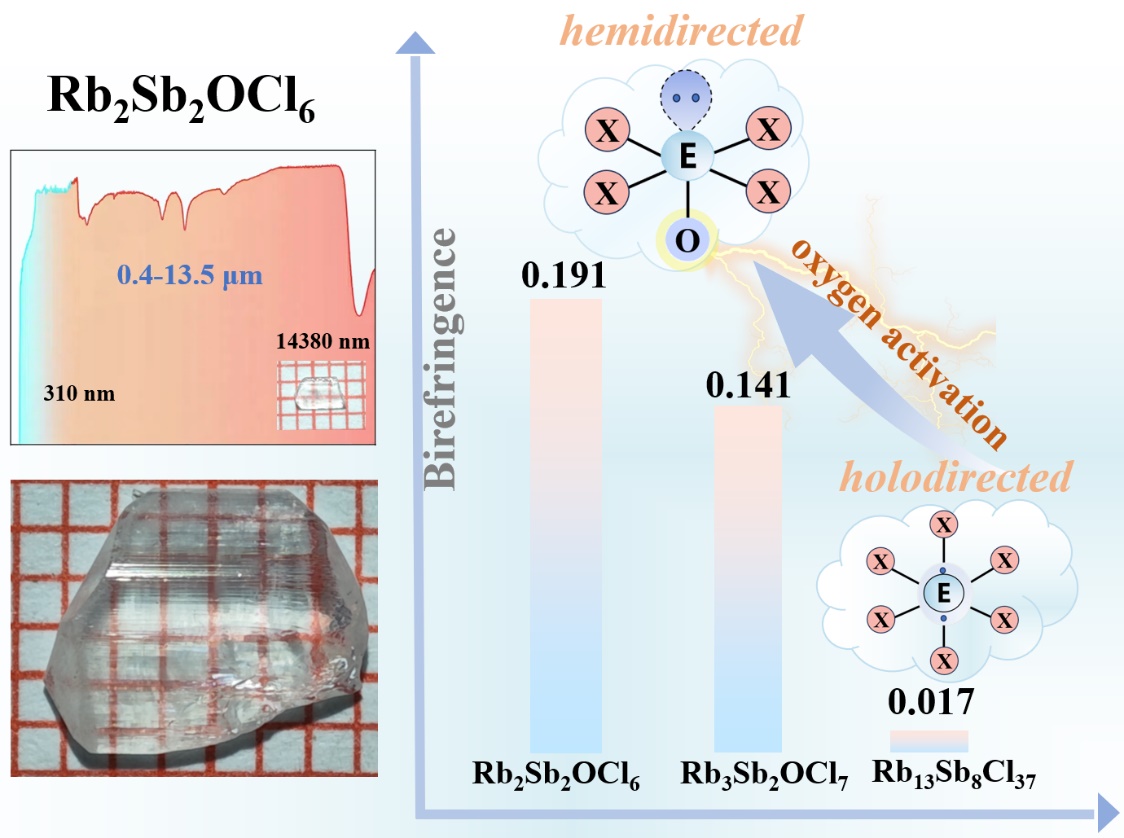
Long-wave infrared birefringent crystals are essential materials in infrared optical applications in fields such as infrared imaging, laser technology, and optical communications. Due to limitations in birefringence, infrared transmission, and crystal growth, high-performance long-wave infrared birefringent crystals have rarely been reported.
Metal halides containing lone-pair electrons are promising candidates for long-wave infrared birefringent materials, however, the "holodirected" coordination configuration of metal ions, particularly when coordinated with heavy halogens, significantly reduces the activity of the lone-pair electrons, thus lowering the birefringence of the structure.
In a study published in Angewandte Chemie International Edition, a research team led by Prof. KONG Fang from Fujian Institute of Research on the Structure of Matter of the Chinese Academy of Sciences discovered a facile route to long-wave infrared birefringent crystal, which is expected to overcome the trade-off between wide infrared transmission and large birefringence.
Researchers proposed an oxygenation strategy, wherein the monovalent halide ion in the halogen polyhedron can been replaced by a divalent oxygen ion, to activate the lone-pair electrons of the central cations, thus enhancing the birefringence of the crystal.
Based on Rb+-Sb3+-Cl- system, researchers obtained three new structures, namely, Rb13Sb8Cl37, Rb3Sb2OCl7, and Rb2Sb2OCl6. As the Cl/Sb ratio decreased in the structure, the Sb3+ coordination geometry transitioned from the "holodirected" octahedron to the "hemidirected " square pyramid. Due to the introduction of oxygen ions, the Sb3+ ions in Rb3Sb2OCl7 and Rb2Sb2OCl6 adopted a square pyramidal geometry with steric activity, and these two compounds represented the first examples of alkali metal antimony(III) oxyhalides.
Moreover, researchers grew a large crystal of Rb2Sb2OCl6 (6×6×2 mm3). Due to the low oxygen content, the infrared cutoff edge of this crystal reached 14380 nm and Rb2Sb2OCl6 can exhibited good transmission performance in the range of 0.4-13.5 μm, which was superior to many reported birefringent crystals.
Furthermore, researchers found that the birefringence of the three new compounds was negatively correlated with the Cl/Sb ratio, and the birefringence of Rb2Sb2OCl6 reached 0.191 @550 nm, which is 11.2 times that of Rb13Sb8Cl37 (0.017 @550 nm). Therefore, Rb2Sb2OCl6 is a promising long-wave infrared birefringent crystal.
This study not only develop a new material system—alkali metal antimony(III) oxyhalides. This study explores the relationship between the geometric structure, electronic structure, and optical properties of lone-pair electron-containing metal oxyhalides, providing a new strategy for the development of long-wave infrared birefringent crystals.

The large crystal and transmission spectrum of Rb2Sb2OCl6, the birefringence and coordination mode of Sb3+ of Rb13Sb8Cl37, Rb3Sb2OCl7, and Rb2Sb2OCl6. (Image by Dr. LI Xinyang)

86-10-68597521 (day)
86-10-68597289 (night)

52 Sanlihe Rd., Xicheng District,
Beijing, China (100864)

